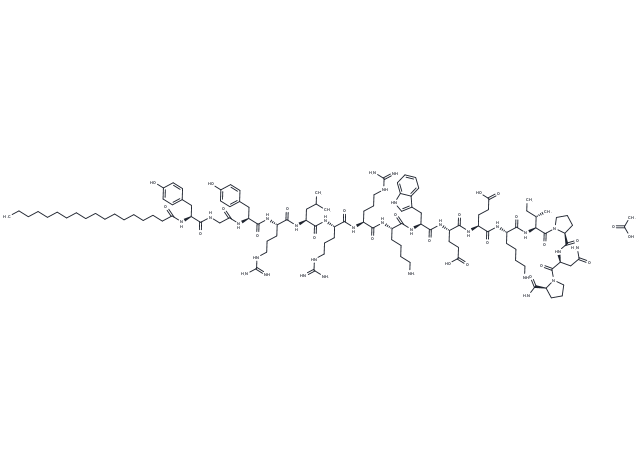Shopping Cart
- Remove All
 Your shopping cart is currently empty
Your shopping cart is currently empty

Lyn peptide inhibitor acetate is a potent and cell-permeable inhibitor of Lyn-coupled IL-5 receptor signaling pathway, while keeping other signals intact. Lyn peptide inhibitor blocks Lyn activation and inhibits the binding of Lyn tyrosine kinase to βc subunit of IL-3/GM-CSF/IL-5 receptors. Lyn peptide inhibitor can be used for study of asthma, allergic, and other eosinophilic disorders.

| Pack Size | Price | Availability | Quantity |
|---|---|---|---|
| 1 mg | $80 | In Stock | |
| 5 mg | $181 | In Stock | |
| 10 mg | $272 | In Stock | |
| 25 mg | $448 | In Stock | |
| 50 mg | $630 | In Stock | |
| 100 mg | $852 | In Stock | |
| 200 mg | $1,130 | In Stock |
| Description | Lyn peptide inhibitor acetate is a potent and cell-permeable inhibitor of Lyn-coupled IL-5 receptor signaling pathway, while keeping other signals intact. Lyn peptide inhibitor blocks Lyn activation and inhibits the binding of Lyn tyrosine kinase to βc subunit of IL-3/GM-CSF/IL-5 receptors. Lyn peptide inhibitor can be used for study of asthma, allergic, and other eosinophilic disorders. |
| Alias | Lyn peptide inhibitor acetate(222018-18-0 free base) |
| Molecular Weight | 2430.98 |
| Formula | C117H188N30O26 |
| Smiles | CCCCCCCCCCCCCCCCCC(N[C@H](C(NCC(N[C@H](C(N[C@H](C(N[C@H](C(N[C@H](C(N[C@H](C(N[C@H](C(N[C@H](C(N[C@H](C(N[C@H](C(N[C@H](C(N[C@H](C(N1CCC[C@H]1C(N[C@H](C(N2CCC[C@H]2C(N)=O)=O)CC(N)=O)=O)=O)[C@H](CC)C)=O)CCCCN)=O)CCC(O)=O)=O)CCC(O)=O)=O)CC3=CNC4=CC=CC=C43)=O)CCCCN)=O)CCCNC(N)=N)=O)CCCNC(N)=N)=O)CC(C)C)=O)CCCNC(N)=N)=O)CC5=CC=C(O)C=C5)=O)=O)CC6=CC=C(O)C=C6)=O.CC(O)=O |
| Relative Density. | no data available |
| Storage | keep away from moisture | Powder: -20°C for 3 years | In solvent: -80°C for 1 year | Shipping with blue ice. | |||||||||||||||
| Solubility Information | H2O: 5 mM, Sonication is recommended. DMSO: Insoluble | |||||||||||||||
Solution Preparation Table | ||||||||||||||||
H2O
| ||||||||||||||||

Copyright © 2015-2025 TargetMol Chemicals Inc. All Rights Reserved.